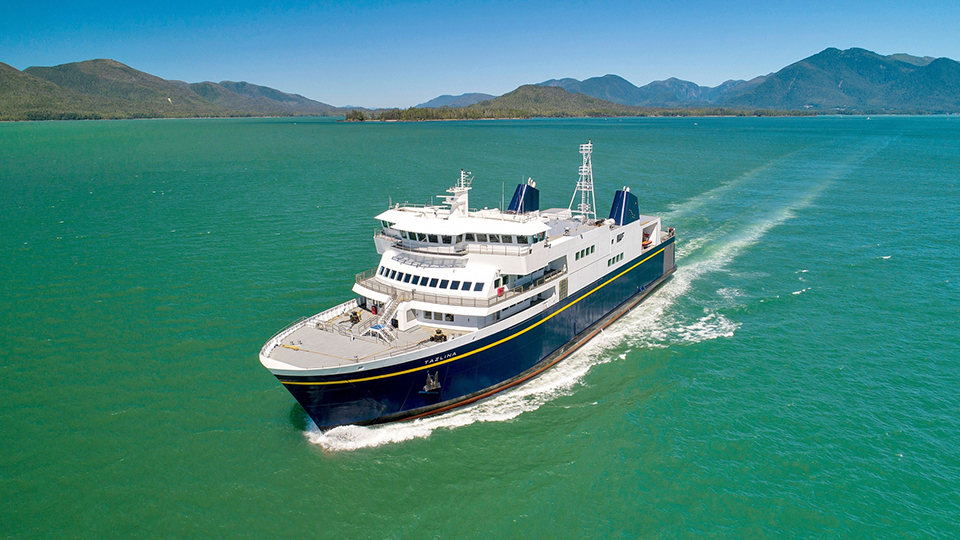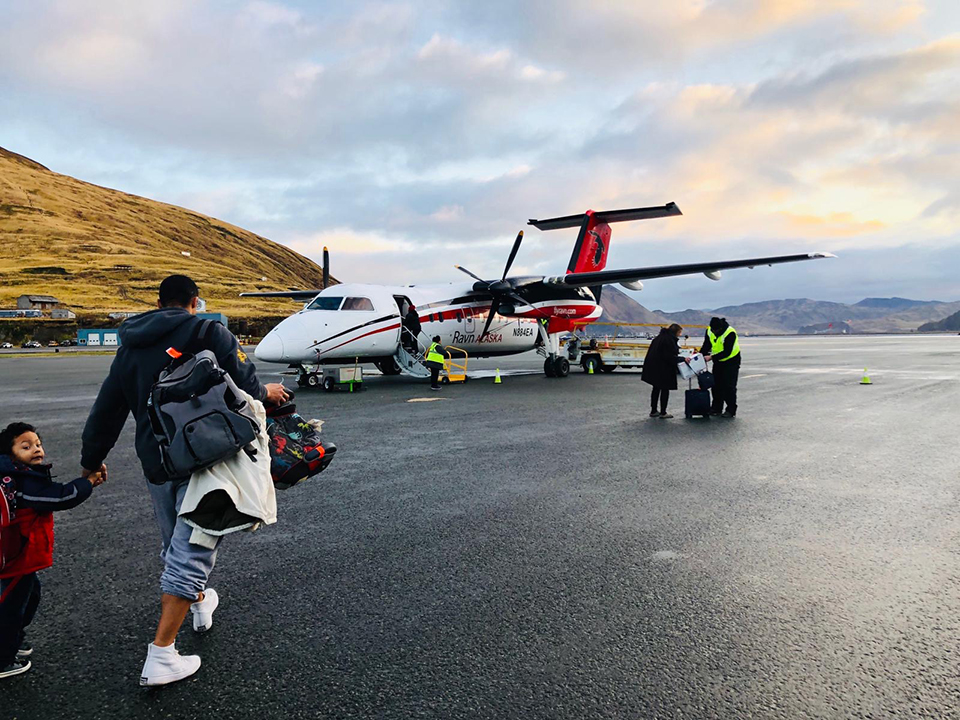If you’ve ever flown into Dutch Harbor, you know it can be an adventure. I remember a jet landing in which the pilot immediately reversed thrust and hit the brakes so hard that my head hit the seatback in front of me. At least we didn’t run off the end of the runway.
Unfortunately, that’s what happened to a PenAir/RavnAir flight last October. The aircraft was a twin-engine turboprop Saab 2000 with 39 passengers, including a swim team from Cordova. Another passenger, David Oltman, a 38-year-old man from Wenatchee, Wash., was killed when the plane crashed into rocks and a broken propeller blade slashed through the cabin.
The accident highlighted ongoing problems with the Dutch Harbor/Unalaska airport. Built at the edge of Amaknak Island, the runway is relatively short and narrow, 4,500 feet (total) long by 100 feet wide, with water at both ends and along most of the southwest side. To the northeast: the base of a mountain. Winds are notoriously strong coming off the Bering Sea and extremely variable. When the PenAir plane landed — on a second approach after one go-round — the wind was nearly 30 knots and on its tail. That the pilots hadn’t turned around and landed into the wind puzzled many observers. Neither pilot had logged much time in the Saabs.
Back in the ’80s, Dutch Harbor/Unalaska enjoyed mainline jet service, provided first by Alaska Airlines and then MarkAir. Both flew Boeing 737-200s, which were capable of landing and taking off from the short strip, if barely. But Alaska stopped flying 737s, and MarkAir went bankrupt after a failed expansion to the Lower 48. PenAir, another regional Alaska airline with national ambitions, also went bankrupt.
The most recent casualty is RavnAir, the state’s largest regional airline. In 2018, it had purchased PenAir assets after its bankruptcy. Ravn, with PenAir’s planes, provided daily service between Anchorage and Dutch Harbor with Saab 2000s and Dash-8s. After the October accident, service stopped completely for about a month. Alaska also curtailed its code-share and marketing arrangements with Ravn after the accident.
The coronavirus pandemic was the next hit. Air travel plummeted everywhere. With a stated 90 percent loss of revenue, RavnAir Group stopped all operations on April 5, grounding 72 aircraft, laying off 1,300 employees. It filed for Chapter 11 bankruptcy. In a letter to customers, Dave Pflieger, Ravn CEO, said these actions would “give us time to ‘hit pause’ while we seek federal CARES Act grants... and emerge successfully once [the pandemic] has passed.”
Suddenly, Dutch Harbor/Unalaska was again without scheduled airline service. Even during a pandemic, the top seafood port in the country needs a way to fly people in and out, regularly.
“We’re seeing a lot of companies charter planes out of Anchorage,” said Stephanie Madsen, executive director of At-Sea Processors Association, in Juneau. “And around May 15th, Alaska Airlines set up a hub in Cold Bay, like back in the good old days.”
Because it has a huge runway, Cold Bay has historically been used for large planes thanks to its two paved landing strips built during World War II, one of which is over 10,000 feet.
For many years, Reeve Aleutian Airlines used Cold Bay as a hub for both Lockheed Electra turboprops and Boeing 727 jets. Reeve provided scheduled service between Cold Bay and Anchorage, and also, in the late ’70s and early ’80s, direct flights between Seattle and Cold Bay. In 2000, Reeve ceased operations.
“Reeve didn’t really change with the times, and none of the kids wanted to take it over,” said Madsen, who lived in Unalaska from 1980 to 1999. Her husband, Tom Madsen, was a well-known bush pilot in the Aleutians. He died in an accident near Juneau in 2002. The state of Alaska renamed the Dutch Harbor/Unalaska airport in his honor that same year.
So for several months this spring and summer, the only scheduled service to Dutch was an Alaska Airlines jet to Cold Bay on a Wednesday or Saturday with a Grant Aviation shuttle to Dutch Harbor. Weather permitting. If not, welcome to Cold Bay.
Many people flew on charters, but that was more expensive and more difficult to manage. A Facebook page was set up to help coordinate available seats on charter flights.
In early July, Ravn Air Group’s assets were put up for auction, and many of its smaller planes were sold. Grant Aviation bought 15 smaller Cessnas. Other small planes were purchased by Yute Commuter Service, Wright Air Service and ACE Air Cargo.
Ravn’s two larger assets, the so-called Part 121 airlines, Ravn Air Alaska and PenAir, were not sold at auction, although there were bidders. But within days of the auction, Ravn suddenly announced that the Part 121 airline certificates and most of the associated aircraft had been sold to a buyer from Southern California, Float Shuttle.
Float Shuttle is a recent start-up that operates a fleet of nine-passenger Cessna 208Bs between general aviation airports in the Los Angeles area. “Vanpool in the sky!” for $1,250 a month, on a subscription basis. Two of the company’s executives have lived and worked in Alaska, and they say they understand what they’re getting into. Naturally, there are skeptics, but people in remote locations like Unalaska, Homer, Unalakleet, Aniak and Kotzebue can anticipate the return of scheduled flights. And other smaller, remote communities may get improved service from Ravn’s smaller aircraft purchased at auction.
Dutch Harbor/Unalaska will still have a short runway with water at both ends, and the notorious weather will cancel many flights. But with the Ravn sale, it looks like the number-one seafood port will get daily air service once again.
Ferry Service
Another scheduled transportation option for getting people and freight to and from Unalaska is the state ferry system. In season, the Alaska Marine Highway System runs the Tustumena between Dutch Harbor and Homer, Seldovia and Kodiak. This year, on the first trip from Homer to Unalaska, one of the crew members tested positive for covid-19 after docking in Dutch Harbor on June 6. The infection was identified by the Iliuliuk Family & Health Services clinic on the island. Twenty-one passengers had already boarded in Dutch Harbor, but they had to get back off the boat after the test result became known. The ferry then headed back to Homer, where additional testing revealed six more crew members were positive for the coronavirus, but no passengers.
All other crew members and six passengers who had already been on the boat got off in Homer. The seven infected crew members stayed in isolation on the Tustumena, a 296-foot ferry that carries up to 211 passengers and 36 vehicles. The Alaska Marine Highway System had said it would return to service on June 27 but that was pushed back to July 2 as a result of “ongoing covid-19 mitigation,” according to the Alaska Department of Transportation and Public Facilities.

While the Tustumena was tied up because of covid, only two of the other 11 boats in the fleet were active. Nine of twelve Alaska ferries were either out of service or in layup, including the two newest boats, the Hubbard and the Tazlina, both of which were recently built at the Vigor shipyard in Ketchikan.
Even before the pandemic, the Alaska Marine Highway System was in crisis. In early 2019, the newly elected governor, Mike Dunleavy, proposed a 75 percent budget cut for the state ferry system. Many legislators cried foul, but the system budget was still cut by about 50 percent, and service to many communities was curtailed or cut off completely through the winter months. Even this summer, when tourist volume is the highest, several boats will remain in layup because of insufficient operating funds or need for repair. The system’s two fast catamarans were pulled from service and put up for sale.
A new working group has been established to address the system’s problems and propose solutions. Adm. Tom Barrett, recently retired president of the Alyeska Pipeline Service Co. and former Deputy Secretary of Transportation under President George W. Bush, chairs the nine-member “reshaping” group, which has until the end of September to come up with recommendations to be implemented in fiscal year 2023.
Robert Venables, executive director of the Southeast Conference and chairman of the state’s Marine Transportation Advisory Board, is also a member of the reshaping group. He says Alaskans want ferry service that is consistent and dependable. Getting there may mean changing the governance structure.
“The powers that be will establish a budget. But to have a maritime enterprise, we really need to have maritime business people at the helm,” he said. Venables recommends a seven-member board that includes maritime professionals, business finance experts and labor.







